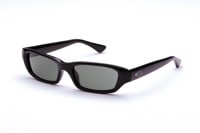Eye On Equipment
Pointers for Polarized Lens Processing
By Susan P. Tarrant
Polarized sunwear is a real revenue center, but if you're continuing to send all your premium sun lens jobs out to wholesale labs, you're losing a piece of your pie. To help assuage any misconceptions that you can't edge polarized lenses in-house, we asked our pool of edging equipment experts for some tips to make the job easier.
DENOUNCING DELAMINATION
PROBLEM: How can I avoid surface damage of a polarized lens while edging?
SOLUTION: Delamination should not be a problem when edging with today's newer patternless edgers that feature a fragile lens setting and automatic bevel placement. For the best results, edge the lens on the "fragile" lens setting.
Bevel placement is also important. Select a front profile bevel position so that the eyewire is close to the fusion point of the polarized surface. This front placement helps prevent delamination and also hides any clear rim around the lens edge.
Jerome Prentout, technical director, Briot-Weco USA
|
|
|
|
Edging is easy with modern equipment. Shown below: Smith Optical sunwear |
|
POLARIZATION HESITATION
PROBLEM: I sell a lot of sunwear and I'd love to be able to finish the sun lenses in-house, just like the majority of my clear lens jobs, but I am worried about the level of difficulty involved in edging polarized lenses--should I be?
SOLUTION: You should not be afraid of adding polarized sun lenses to your repertoire. Finishing them is not much different than other lenses, with just a couple of exceptions.
The major concern is the placement of the bevel. Polarized lenses are made by placing a film between two lenses. If the bevel is put on the lens at the point where the lenses come together, they can separate.
Using a custom bevel function like those available on several of today's edgers eliminates the problem, because it lets you decide where to place the bevel on special jobs.
Marc Okrant, product manager, Gerber Coburn
AVOIDING EXPENSIVE RE-DOS
PROBLEM: I am encountering a lot of polarized lens re-dos. What could I be doing wrong?
SOLUTION: There aren't many things different about polarized lenses when it comes to edging, but working with the polarization of the lens can be tricky.
When edging, pay special attention to the 180 degree reference line for layout purposes. You must lay out the polarized lens along a specified 180 degree line so that the polarization works properly.
That could be your main problem.
Matt Vulich, vice president of sales, AIT Industries
SOLVING THE SHELF PROBLEM
PROBLEM: Every time I attempt to edge polarized lenses, they don't look right around the edges. What can I do?
SOLUTION: Polarized lenses sometimes need extra attention around the edges. If the bevel is placed automatically during the edging cycle, a little bit of a "shelf" will be left in front of the bevel, depending on the power of the lens. It's actually the front edge of the bevel. Usually, this is not noticeable. But with a polarized lens, the white line that is the polarization film will be seen.
The way to solve this problem is to control the bevel placement, and perform a "guided front bevel," in which the operator actually guides the lens through the beveling process, instead of choosing the automatic bevel. Now the lens edge is completely hidden behind the frame, so there's no white line.
Franco Aluigi, product manager, Santinelli International
|
Number One Problem: Blocking |
Polarized lenses are dark, and their polarization makes it difficult to see the markings to ensure proper blocking. So, we asked our equipment experts to provide a few tips to help deal with this common problem.
|




